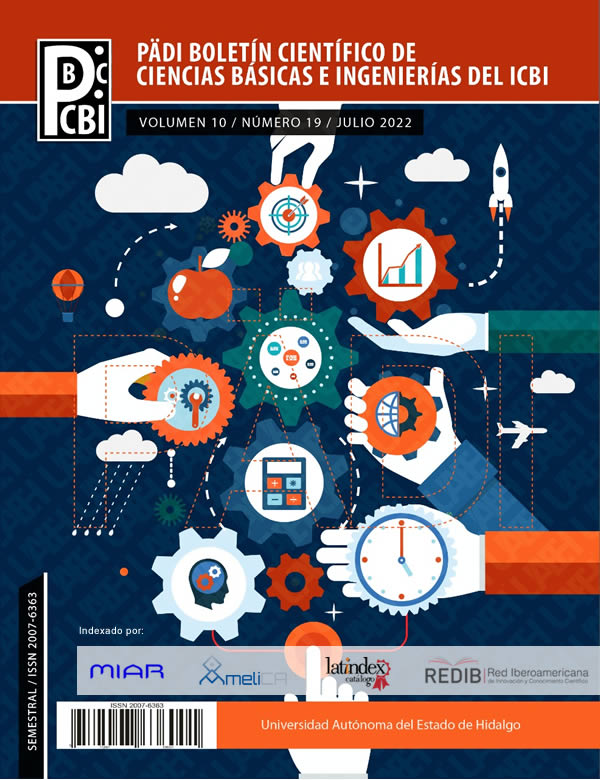Contaminación del suelo por microplásticos: panorama actual
DOI:
https://doi.org/10.29057/icbi.v10i19.9188Palabras clave:
Microplastico, suelo, emergenteResumen
Actualmente los microplásticos (MP) son considerados un contaminante emergente, cuyos efectos en los ecosistemas del planeta han sido poco estudiados, el objetivo de esta investigación es determinar el estado de arte respecto a los MP en la matriz del suelo. Se realizó un análisis de diversas fuentes, como publicaciones revisadas por pares, incluidas revistas científicas y libros, en bases de datos que son referenciales académicos incluyendo ScienceDirect, Web of Knowledge, Scopus, Web of Science, entre otras. No se definió en la investigación un rango específico de tiempo con relación de artículos debido a la baja disponibilidad de trabajos. Se analizaron 96 artículos con diferentes temáticas de las cuales destacan las publicaciones con enfoque experimental y de investigación. De acuerdo al análisis realizado se concluye que los MP son un tipo de contaminación emergente y debido a que el interés por conocer sus efectos es reciente, aún existen pocos datos, como consecuencia se desconocen las concentraciones en suelos, así como las afectaciones al ambiente y a la salud humana, este tópico aún pasa por su etapa de investigación teórica.
Descargas
Información de Publicación
Perfiles de revisores N/D
Declaraciones del autor
Indexado en
- Sociedad académica
- N/D
Citas
Allen, S., Allen, D., Phoenix, V. R., le Roux, G., Durántez Jiménez, P., Simonneau, A., Binet, S., & Galop, D. (2019). Atmospheric transport and deposition of microplastics in a remote mountain catchment. Nature Geoscience, 12(5), 339–344.
Álvarez-López Tello, J., Robles, C., & del Castillo, R. F. (2021). Microplastic pollution in neotropical rainforest, savanna, pine plantations, and pasture soils in low landareas of Oaxaca, Mexico: Preliminary results. Ecological Indicators, 121, 107084. https://doi.org/10.1016/j.ecolind.2020.107084
Beriot, N., Peek, J., Zornoza, R., Geissen, V., & Huerta Lwanga, E. (2021). Low density-microplastics detected in sheep faeces and soil: A case study from the intensive vegetable farming in Southeast Spain. Science of the Total Environment, 755, 142653. https://doi.org/10.1016/j.scitotenv.2020.142653
Castañeta, G., Gutiérrez, F. A., Nacaratte, F. y Manzano, A. C. (2020). Microplásticos: un contaminante que crece en todas las esferas ambientales, sus características y posibles riesgos para la salud pública por exposición. Revista Boliviana de Química, 37(3), 160-175. DOI:10.34098/2078-3949.37.3.4
Chatterjee, S., & Sharma, S. (2019). Microplastics in our oceans and marine health. Field Actions Science Reports, 1(1), 54–61. https://journals.openedition.org/factsreports/5257
Duis, K., & Coors, A. (2016). Microplastics in the aquatic and terrestrialenvironment: sources (with a specificfocuson personal careproducts), fate and effects. Environmental Sciences Europe, 28(1). https://doi.org/10.1186/s12302-015-0069-y
DW Deutsche Welle. (2018). ONU: sólo 9 por ciento del plástico usado se recicla. DW.COM. https://www.dw.com/es/onu-s%C3%B3lo-9-por-ciento-del-pl%C3%A1stico-usado-en-el-mundo-se-recicla/a-44077167 (Agosto 2021).
Horton, A. A., Walton, A., Spurgeon, D. J., Lahive, E., & Svendsen, C. (2017). Microplastics in freshwater and terrestrial environments: Evaluating the current understanding to identify theknowledge gaps and future research priorities. Science of The Total Environment, 586, 127–141. https://doi.org/10.1016/j.scitotenv.2017.01.190
Huerta L wanga, E., Mendoza Vega, J., Ku Quej, V., Chi, J. D. L. A., S Del Cid, L., Chi, C., Escalona Segura, G., Gertsen, H., Salánki, T., van der Ploeg, M., Koelmans, A. A., & Geissen, V. (2017). Field evidencefor transfer of plastic debris along a terrestrial food chain. Scientific Reports, 7(1). https://doi.org/10.1038/s41598-017-14588-2
Kumar, M., Xiong, X., He, M., Tsang, D. C., Gupta, J., Khan, E., Harrad, S., Hou, D., Ok, Y. S., & Bolan, N. S. (2020). Microplastics as pollutants in agricultural soils. Environmental Pollution, 265, 114980. https://doi.org/10.1016/j.envpol.2020.114980
Lei, L., Liu, M., Song, Y., Lu, S., Hu, J., Cao, C., Xie, B., Shi, H., He, D., 2018. Polystyrene (nano) microplastics cause size-dependent neurotoxicity, oxidative damage and other adverse effects in Caenorhabditis elegans. Environmental Science: Nano, 5(8), 2009e2020. https://doi.org/10.1039/C8EN00412A
Nizzetto, L., Futter, M., & Langaas, S. (2016). Are Agricultural Soils Dumps for Microplastics of Urban Origin? Environmental Science & Technology, 50(20), 10777–10779.
Rillig, M. C. (2012). Microplastic in Terrestrial Ecosystems and the Soil? Environmental Science & Technology, 46(12), 6453–6454.
Rillig, M. C., de Souza Machado, A. A., Lehmann, A., & Klümper, U. (2019). Evolutionary implications of microplastics for soil biota. Environmental Chemistry, 16(1), 3. https://doi.org/10.1071/en18118
Rillig, M. C., Ingraffia, R., & de Souza Machado, A. A. (2017). Microplastic Incorporation into Soil in Agroecosystems. Frontiers in Plant Science, 8. https://doi.org/10.3389/fpls.2017.01805
Roa, M. M. (2021, 4 junio). ¿Qué países generan más residuos de plástico de un solo uso? Statista Infografías. https://es.statista.com/grafico/25010/paises-con-la-mayor-cantidad-de-residuos-plasticos-de-un-solo-uso-generados/#:%7E:text=Los%20tres%20pa%C3%ADses%20m%C3%A1s%20poblados,persona%20var%C3%ADa%20notablemente%20entre%20ellos
Rumin, Q., Davey, J., Zhen, L., Qin, L., &Changrong, Y. (2020). Behavior of microplastics and plastic film residues in the soil environment: A criticalreview. Science of the Total Environment, 703(134722), 4-48. https://doi.org/10.1016/j.scitotenv.2019.134722
Thompson, R. C., Swan, S. H., Moore, C. J., &vomSaal, F. S. (2009). Our plastic age. Philosophical Transactions of the Royal Society B: Biological Sciences, 364(1526), 1973–1976.
Weber, C. J., Weihrauch, C., Opp, C., & Chifflard, P. (2020). Investigating microplastic dynamics in soils: Orientation for sampling strategies and sample pre‐procession. Land Degradation & Development, 32(1), 270–284. https://doi.org/10.1002/ldr.3676
Zhang, Y., Kang, S., Allen, S., Allen, D., Gao, T. and Sillanpää, M. (2020). Atmospheric microplastics: A review on current status and perspectives. Earth Science Reviews, 203; 103118 https://doi.org/10.1016/j.earscirev.2020.103118
Zhu, D., Chen, Q.L., An, X.L., Yang, X.R., Christie, P., Ke, X., Wu, L.H., Zhu, Y.G. (2018). Exposure of soil collembolans to microplastics perturbs their gut microbiota and alters their isotopic composition. Soil Biology and Biochemistry, 116, 302e310. https://doi.org/10.1016/j.soilbio.2017.10.027.
Zubris, K. A. V., & Richards, B. K. (2005). Synthetic fibers as an indicator of land application of sludge. Environmental Pollution, 138(2), 201–211. https://doi.org/10.1016/j.envpol.2005.04.013




















